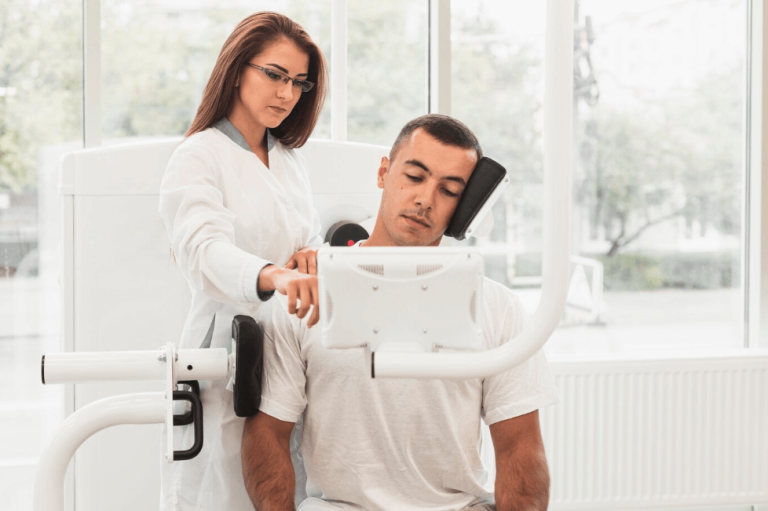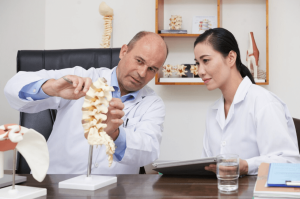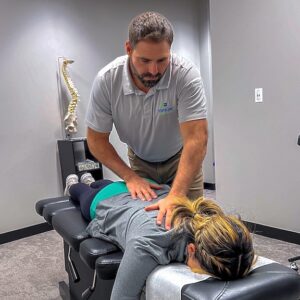Pain, an unwelcome companion for many, can significantly disrupt daily life. From acute injuries to chronic conditions, seeking relief often leads individuals on a quest to explore diverse treatment options. Among these options, soft wave therapy, commonly known as cold laser therapy near me, has gained attention for its potential in pain management. But when is the ideal time to consider this innovative treatment for effective relief?
Understanding Soft Wave Therapy
Soft wave therapy involves using low-level lasers or light-emitting diodes (LEDs) to stimulate cell function, promote healing, and reduce pain and inflammation. The treatment is non-invasive, with minimal or no side effects, making it an appealing alternative to medications or surgical procedures for certain conditions.
Cellular Healing Mechanism: Soft wave therapy, leveraging low-level lasers or LEDs, operates on a fascinating cellular mechanism. The emitted non-thermal photons penetrate deep into the tissues, stimulating the powerhouse of cells – the mitochondria. This stimulation jumpstarts enhanced cellular energy production, known as adenosine triphosphate (ATP). With increased ATP, cells have the energy needed for faster tissue repair and reduced inflammation. This intricate process directly contributes to the alleviation of pain by promoting a natural healing response within the body.
Non-Invasive Nature: A defining aspect of soft wave therapy lies in its non-invasive nature. Unlike surgical procedures or other invasive treatments, this therapy employs targeted light energy, precisely directing it to the affected area. The controlled emission of light ensures that surrounding tissues remain unharmed. This non-invasive attribute makes soft wave therapy an attractive option for individuals seeking pain relief without the risks associated with more invasive interventions, offering a safer and less traumatic healing process.
Pain Reduction and Inflammation Management: Soft wave therapy is specifically designed to address two primary concerns: reducing pain and managing inflammation. By utilizing light energy, this therapy disrupts pain signals transmitted by nerve cells, thereby reducing the sensation of pain. Simultaneously, it modulates the production of pro-inflammatory molecules, such as cytokines, ultimately curbing the inflammatory response. This dual action provides patients with not only relief from discomfort but also an environment conducive to accelerated healing.
Versatility in Treating Various Conditions: The adaptability of soft wave therapy extends across a broad spectrum of conditions. Its effectiveness is observed in acute injuries, including strains, sprains, and sports-related traumas. Moreover, it showcases remarkable outcomes in addressing chronic conditions such as arthritis, fibromyalgia, and neuropathy. This versatility is a testament to the therapy’s efficacy in catering to diverse patient needs, making it a sought-after choice in pain management.
Minimal to No Side Effects: Soft wave therapy boasts an impressive safety profile, with minimal to no reported long-term side effects. Unlike certain medications that may cause adverse reactions or complications, this therapy presents itself as a low-risk alternative. Patients undergoing soft wave therapy typically experience no detrimental effects on their overall health, enhancing its appeal as a pain relief option without the concern of additional health complications.
Complementary Role in Holistic Healthcare: The collaborative nature of soft wave therapy makes it an ideal complementary addition to various healthcare modalities. It seamlessly integrates into holistic approaches, aligning with practices such as chiropractic care, physical therapy, or conventional medical treatments. Its synergy with other therapies amplifies the overall effectiveness of treatment strategies, advocating for a comprehensive approach to healing and pain management that caters to individual patient needs.
Identifying Suitable Conditions for Cold Laser Therapy
Acute Injuries: Cold laser therapy demonstrates exceptional efficacy in treating acute injuries, including strains, sprains, and sports-related traumas. Administering this therapy promptly after an injury can significantly reduce swelling, inflammation, and pain. By accelerating the body’s natural healing processes, it aids in repairing damaged tissues, promoting faster recovery, and minimizing the risk of chronic issues stemming from the initial injury.
Inflammation Reduction: Cold laser therapy’s profound impact on reducing inflammation makes it a valuable treatment option for various conditions where inflammation plays a central role in perpetuating pain and limiting mobility. By mitigating inflammation at a cellular level, it aids in restoring healthier tissue function and alleviating discomfort.
Wound Healing: The therapy’s capacity to stimulate cellular activity and promote tissue regeneration makes it an effective option for enhancing the healing of wounds, cuts, and ulcers. By accelerating the body’s natural healing process at the cellular level, cold laser therapy fosters quicker recovery while potentially reducing the risk of infections and complications.
Joint Disorders: Cold laser therapy’s ability to reduce inflammation and alleviate pain makes it particularly beneficial for joint-related disorders such as osteoarthritis and rheumatoid arthritis. By targeting affected joint areas, it helps in managing pain, improving joint mobility, and minimizing the impact of these debilitating conditions on an individual’s daily life.
Neurological Disorders: For certain neurological conditions causing pain, such as neuropathy or nerve-related discomfort, cold laser therapy aids in targeting nerve endings. By stimulating nerve regeneration and modulating pain signals, it can contribute to managing these conditions effectively, reducing discomfort and improving nerve function over time.
Musculoskeletal Conditions: Soft tissue injuries, muscle strains, and ligament tears benefit from cold laser therapy McHenry due to its capacity to accelerate the healing process. By enhancing cellular repair mechanisms and minimizing scar tissue formation, it aids in restoring tissue integrity, promoting flexibility, and reducing the likelihood of recurring injuries.
Sports Injuries Prevention: Athletes often integrate cold laser therapy into their routines not just for injury recovery but also as a preventive measure. Regular sessions can enhance tissue resilience, reduce muscle fatigue, and improve recovery between workouts or competitions, thereby decreasing the risk of sports-related injuries.
Chronic Conditions Management: Patients dealing with chronic conditions characterized by recurring pain episodes, such as migraines or temporomandibular joint (TMJ) disorders, may find relief and improved management through consistent application of cold laser therapy. By reducing pain intensity and frequency, it enhances the individual’s ability to cope with these conditions, improving their overall quality of life.
Optimal Timing for Soft Wave Therapy
Golden Hours Post-Injury: Soft wave therapy administered within the crucial “golden hours” after an injury (typically within the first 24-48 hours) capitalizes on the body’s heightened responsiveness to treatment. During this acute phase, the therapy’s ability to mitigate inflammation, improve blood circulation, and jumpstart the body’s natural healing mechanisms is most potent. By promptly addressing inflammation and tissue damage, it aids in reducing recovery time and potential long-term complications.
Pre-Emptive Treatment for High-Risk Activities: For individuals engaged in high-risk activities or sports prone to injuries, preemptive soft wave therapy sessions act as a proactive measure. These sessions not only prepare the body by improving tissue resilience and strengthening affected areas but also mitigate the risk and severity of potential injuries. Through targeted treatment, the therapy aims to enhance tissue health, thereby reducing susceptibility to injury.
Strategic Integration in Rehabilitation Programs: Integrating soft wave therapy strategically into rehabilitation programs, especially in the initial phases, amplifies its impact. During these crucial stages, when the body is adapting to recovery protocols, the therapy aids in pain management, tissue regeneration, and restoration of mobility. By aligning therapy sessions with the rehabilitation process, it supports a more efficient and comprehensive recovery.
Repetitive Stress Injuries and Cumulative Benefits: In cases of conditions stemming from repetitive stress or overuse, such as carpal tunnel syndrome or tennis elbow, the consistent application of soft wave therapy yields cumulative benefits. Regular sessions work towards gradual tissue repair, reducing inflammation, and mitigating chronic pain. Over time, the therapy aids in enhancing tissue resilience, promoting better function, and alleviating discomfort associated with these conditions.
Window of Opportunity Pre-Surgery: Administering soft wave therapy before surgery, particularly during the preparatory phase, creates an optimal environment for the upcoming procedure. By mitigating inflammation, improving blood circulation, and enhancing tissue health, the therapy assists in preparing the body for surgery. This pre-surgical treatment aims to reduce post-operative complications and foster a smoother recovery process.
Post-Surgery Healing Enhancement: In the post-surgery phase, soft wave therapy contributes significantly to healing and recovery. It assists in reducing post-operative pain, minimizing scar tissue formation, and accelerating wound healing. Through targeted treatment, it aids in restoring tissue integrity and functionality, thus shortening the recovery period and optimizing overall surgical outcomes.
Customized Treatment Frequency: Tailoring the frequency of soft wave therapy sessions based on individual response to treatment, severity of the condition, and overall health plays a pivotal role in optimizing therapy effectiveness. A personalized approach ensures that the therapy frequency aligns with the individual’s needs, allowing for maximum benefit from each session while preventing overexertion.
Synergistic Combination with Other Modalities: Soft wave therapy exhibits synergistic effects when combined with other complementary treatments like acupuncture, massage therapy, or physiotherapy. Integrating these modalities enhances the overall treatment outcome by addressing multiple aspects of healing and recovery simultaneously. The combined approach often results in a more comprehensive and effective treatment plan.
Maintenance Sessions for Chronic Conditions: Chronic pain conditions, such as osteoarthritis or degenerative joint diseases, benefit from consistent maintenance soft wave therapy sessions. Regular sessions provide ongoing relief, managing symptoms, improving joint function, and enhancing overall quality of life. By addressing the root causes and managing symptoms, the therapy contributes to sustained long-term improvements in these chronic conditions.
Professional Monitoring and Adjustments: Regular check-ins with a healthcare professional specialized in soft wave therapy ensure continual assessment and necessary adjustments to the treatment plan. This proactive approach allows healthcare providers to monitor progress, make necessary modifications, and optimize the timing and frequency of therapy sessions for each individual, thereby ensuring the best possible outcomes.
Why Choose Us?
Introduction: Evolve Chiropractic of McHenry prides itself on being a leading establishment in chiropractic care, renowned for its multifaceted treatment options. The clinic specializes in cutting-edge Cold Laser Therapy, standing as a beacon of innovative healthcare solutions in the region.
Expertise: Our team consists of highly skilled and experienced chiropractors who have undergone rigorous training and continuously refine their expertise in the application of Cold Laser Therapy. We invest in the latest technology and advancements, ensuring our practitioners are at the forefront of this specialized field.
Personalized Approach: We adopt a patient-centric approach, understanding that every individual has distinct requirements. Thus, each treatment plan is meticulously crafted to suit the specific needs and conditions of the patient, ensuring a customized and effective approach to healing.
Safety and Efficacy: Upholding the highest standards of safety and efficacy, our therapists are dedicated to administering Cold Laser Therapy with precision and expertise. Patients can rest assured that their well-being is our top priority throughout the treatment process.
Quick and Painless Sessions: Patients undergoing Cold Laser Therapy at our clinic experience swift and virtually painless sessions. Many individuals report immediate relief and improved mobility following their sessions, significantly contributing to their overall quality of life.
Education and Guidance: Educating our patients about the profound benefits and potential outcomes of Cold Laser Therapy is integral to our approach. We empower our clients with in-depth knowledge, enabling them to make informed decisions regarding their health and treatment options.
Holistic Wellness Integration: Beyond symptom alleviation, we focus on integrating Cold Laser Therapy into a broader spectrum of wellness strategies. By doing so, we aim to promote overall health and support the body’s natural healing mechanisms.
Community Commitment: At Evolve Chiropractic, we hold a deep-rooted commitment to fostering a healthier community by delivering exemplary Cold Laser Therapy services. Through our dedication and expertise in chiropractic care, we aim to positively impact the lives of our patients and contribute to the well-being of the community at large.
3923 Mercy Dr Ste A, McHenry, IL 60050, United States
(815) 271-5901
https://myevolvechiropractor.com/locations/chiropractor-in-mchenry-illinois/





